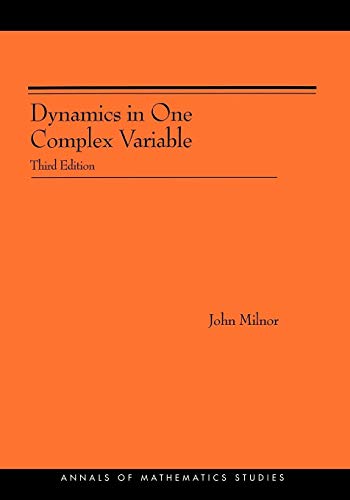

Dynamics in One Complex Variable: Third Edition (Annals of Mathematics Studies, 160)
D**Z
This is a great textbook by a great mathematician and expositor
This is a great textbook by a great mathematician and expositor, and simply should not be missed by anyone interested in the subject, whether beginner or expert. The subject is what happens when a holomorphic function f(z) is iterated to obtain (f o f o ... o f)(z), or in other words f(f(...(f(z))...), as the number of iterations increases indefinitely. The behavior of holomorphic functions under iteration is utterly fascinating, as might be expected from the beautiful and mysterious pictures of the associated Mandelbrot and Julia sets.The author, John Milnor, is a renowned mathematician, a winner of the Fields Medal, and the author of several other superb math books including "Topology From the Differentiable Viewpoint" and "Characteristic Classes" (with James Stasheff). Highly recommended!
J**L
Outstanding appendix on continued fractions in terms of circle rotations
My interest in complex dynamics is its intersection with Diophantine approximation, results like the theorems of Cremer, Siegel, and Arnold. For these I think more understandable accounts are given in Carleson and Gamelin, Complex Dynamics (Universitext / Universitext: Tracts in Mathematics) , Hasselblatt and Katok, A First Course in Dynamics: with a Panorama of Recent Developments , andIlyashenko and Yakovenko, Lectures on Analytic Differential Equations (Graduate Studies in Mathematics) . But Milnor has the best construction I've seen of continued fractions using the language of circle rotations. This occurs in section 11 and Appendix C. All the usual inequalities and identities are proved, and sets of numbers satisfying Diophantine conditions are defined. For these sets, properties like their Hausdorff dimension and measure are established.
B**N
Excellent introduction to a marvelous subject
This is a great book for, say, a beginning graduate student or really anyone else with a solid undergraduate math background who wants to understand what complex dynamics is all about. The exposition is amazingly crisp and clear. Milnor has a knack for efficiently driving towards the central issue in a proof. Some of the material is quite complicated, but you get the sense that you are learning it from a master who has spent a long time grappling with the concepts and has found the cleanest possible presentation. There are lots of helpful diagrams throughout the text. The subject is known for beautifully complex fractal images, some of which are rendered in the book (albeit in fairly low quality black and white). There are places where a little more detail might have made it easier to read, but the independent thinking that is needed to fill in the gaps is ultimately rewarding. For some of the more advanced material (eg Herman rings), only sketches of proofs are given, which is somewhat annoying, but I have a feeling that going through all the details of some of the more difficult proofs would not really be worth the time for someone new to the field. There are many interesting exercises at the end of almost every section, none of them trivial, and some quite difficult. The core of the book concerns the Julia and Fatou sets and the behavior of rational maps around periodic points. Discussion of the famous Mandelbrot set is relegated to an appendix.As for prerequisites, you definitely need to know complex analysis. You also should know some topology, in particular, about covering spaces. Milnor writes in the preface that the reader should be familiar with 2-D differential geometry. I didn't really find that necessary, but it might help in understanding the context of the frequently used hyperbolic metric.
D**T
Very good if..
you have a heavy package indifferentiel geometrycomplex analysistopological algebrariemann geometry.If not, forget it.
J**É
It's a good book
yeah
Trustpilot
1 week ago
1 month ago